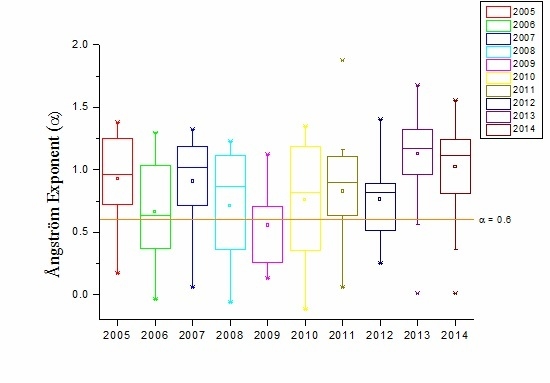Analysis of Aerosol Properties in Beijing Based on Ground-Based Sun Photometer and Air Quality Monitoring Observations from 2005 to 2014
Abstract
:1. Introduction
2. Data and Methodology
2.1. AERONET Observations
| Site | Year | Number of Aerosol Optic Depth and Ångström Parameters (Spring, Summer, Autumn and Winter) | Number of Retrievals of Particle Size Distribution and Other Parameters (Spring, Summer, Autumn and Winter) |
|---|---|---|---|
| Beijing Xianghe | 2005 | 73,67,75,75 79,73,71,73 | 63,40,69,64 68,60,64,64 |
| Beijing Xianghe | 2006 | 82,53,73,75 82,68,78,78 | 73,34,65,67 74,46,69,69 |
| Beijing Xianghe | 2007 | 72,68,73,0 77,66,63,76 | 68,48,63,0 69,49,53,70 |
| Beijing Xianghe | 2008 | 45,45,16,82 36,63,68,77 | 35,13,14,70 29,42,62,68 |
| Beijing Xianghe | 2009 | 84,68,46,73 78,63,58,59 | 70,50,42,63 73,49,49,54 |
| Beijing Xianghe | 2010 | 76,70,74,86 68,60,68,81 | 66,55,64,79 56,46,58,76 |
| Beijing Xianghe | 2011 | 87,76,46,79 86,66,66,69 | 73,53,41,73 71,43,57,66 |
| Beijing Xianghe | 2012 | 80,50,15,68 65,41,70,50 | 71,19,3,57 58,26,65,24 |
| Beijing Xianghe | 2013 | 82,54,48,69 80,56,74,33 | 74,45,39,65 71,42,66,24 |
| Beijing Xianghe | 2014 | 78,67,47,76 82,76,63,82 | 68,48,18,39 36,47,47,74 |
2.2. Air Quality Monitoring
| IAPI | Daily SO2 Concentration (μg/m3) | Daily NO2 Concentration (μg/m3) | Daily PM10 Concentration (μg/m3) |
|---|---|---|---|
| 50 | 50 | 80 | 50 |
| 100 | 150 | 120 | 150 |
| 200 | 800 | 280 | 350 |
| 300 | 1600 | 565 | 420 |
| 400 | 2100 | 750 | 400 |
| 500 | 2620 | 940 | 600 |
3. Results
3.1. Aerosol Optic Depth (AOD) Trends
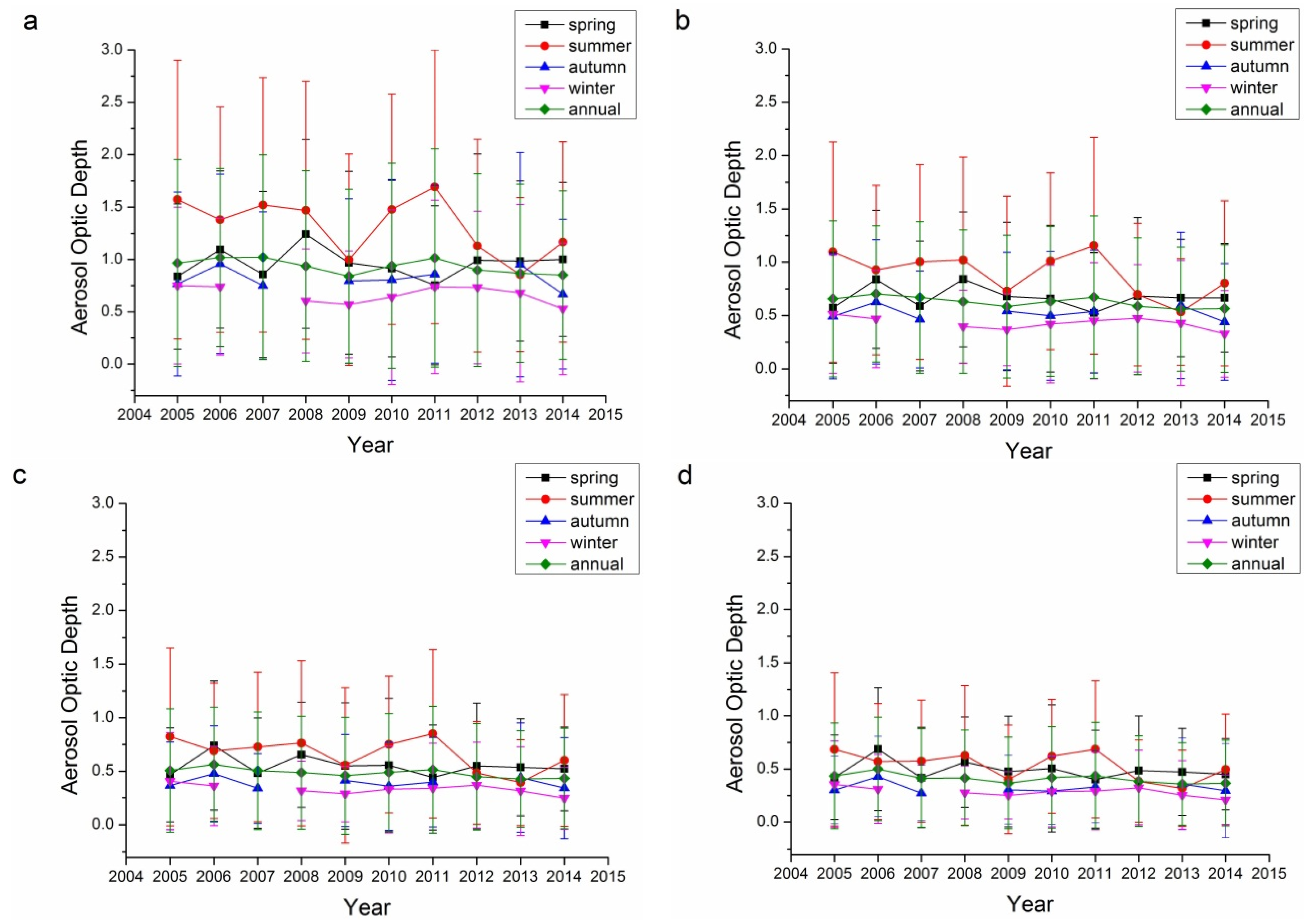
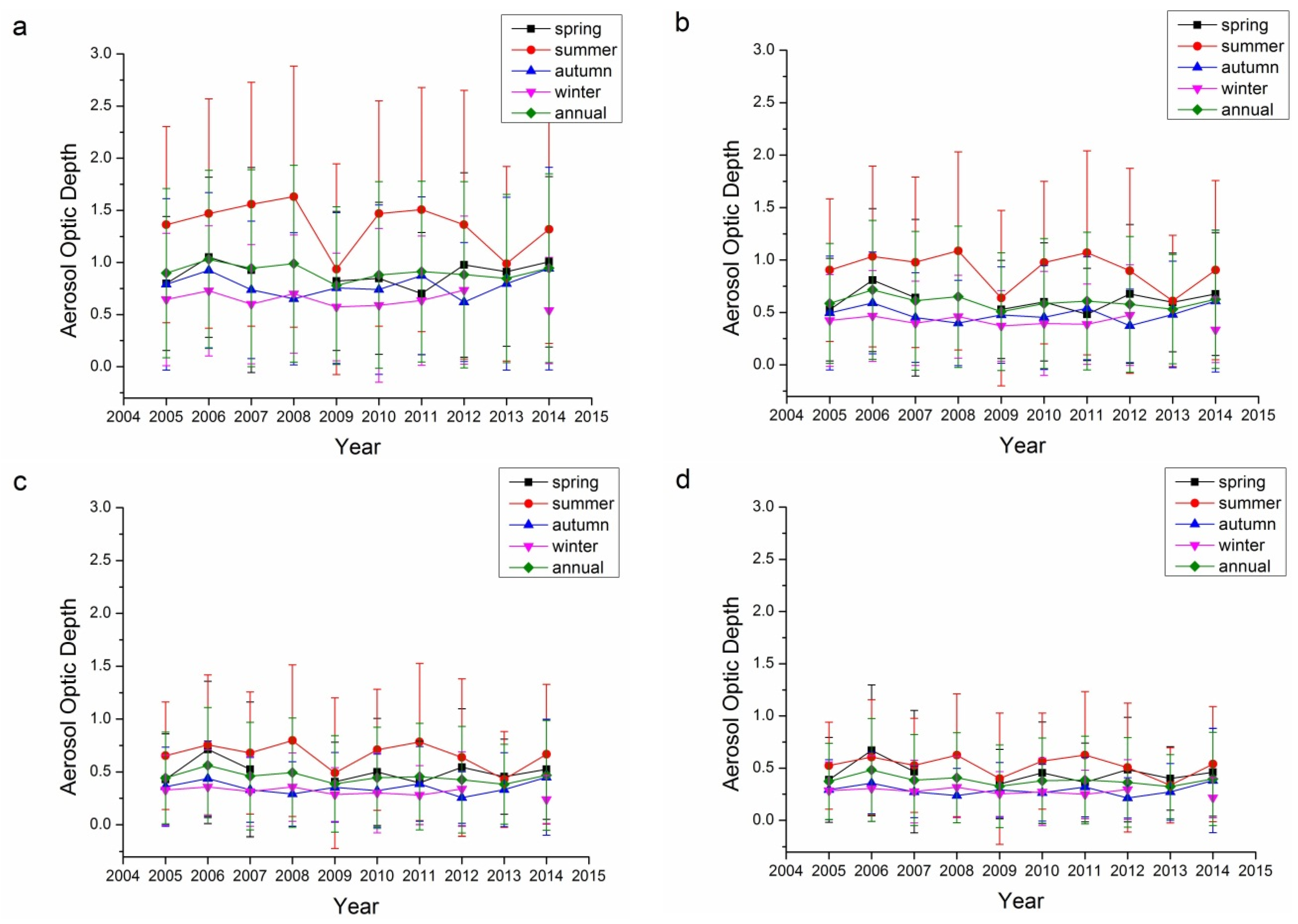
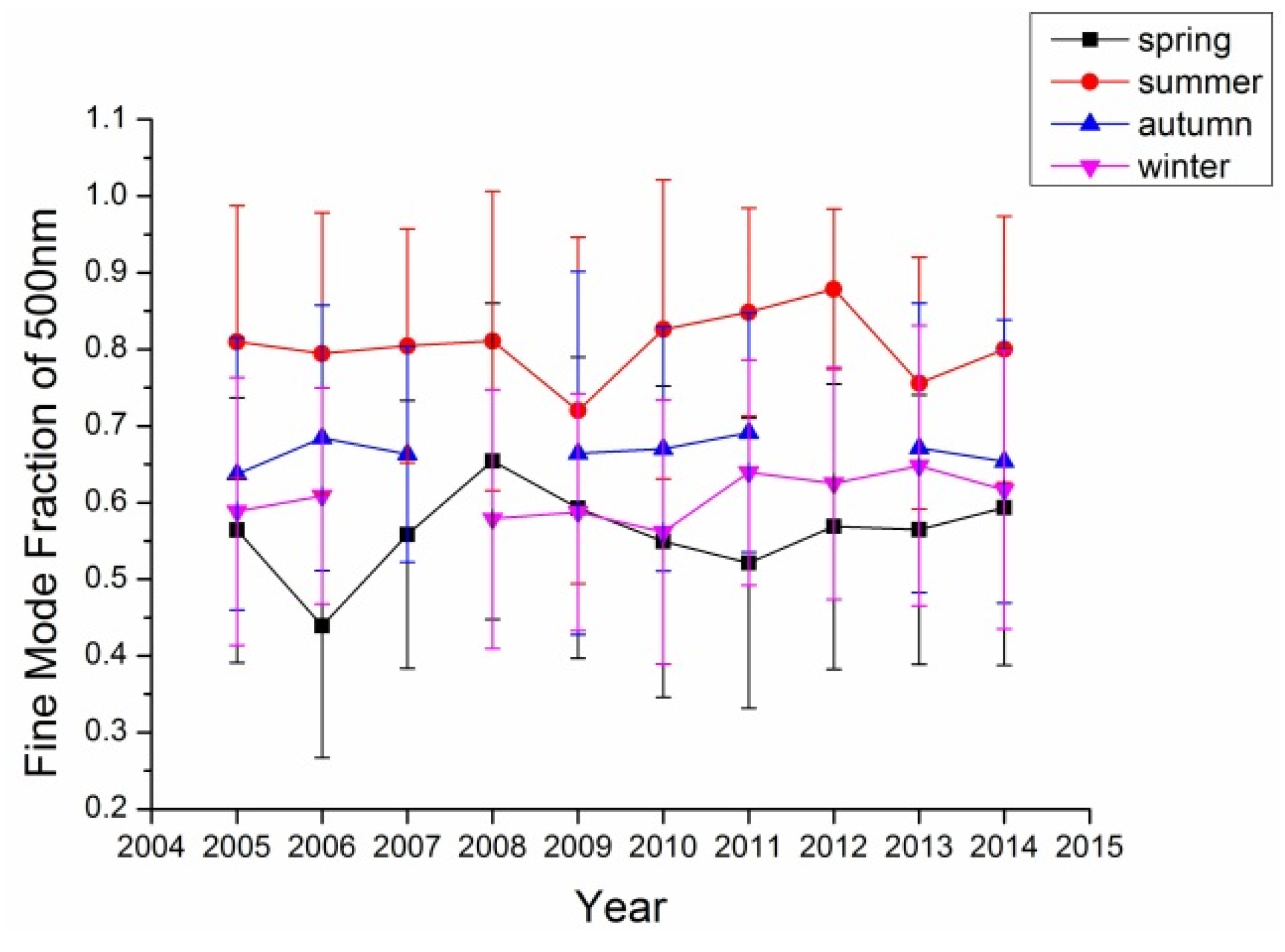
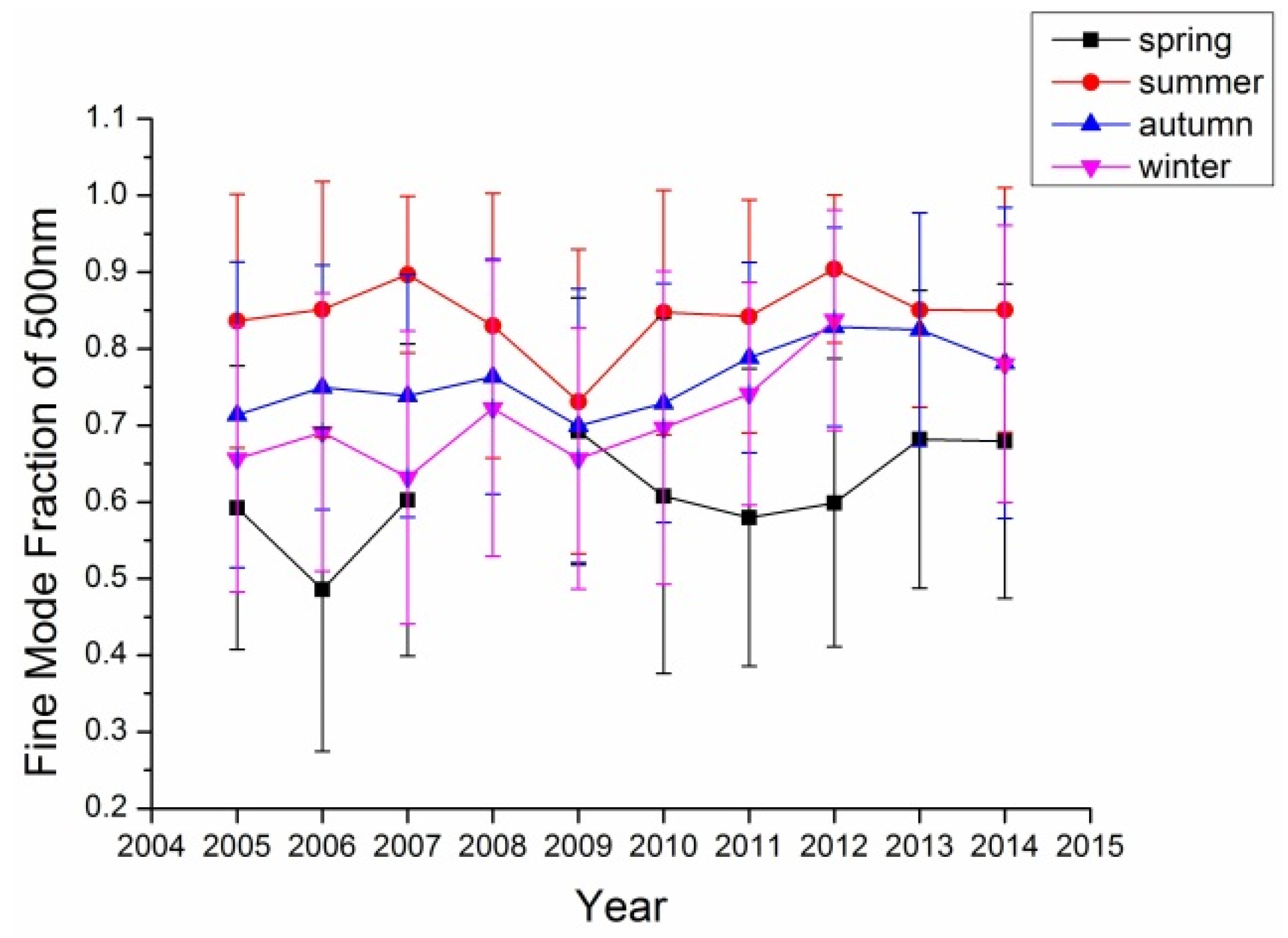
| Season | Average AOD and Range for 440 nm | Average AOD and Range for 440 nm | Average AOD and Range for 440 nm | Average AOD and Range for 440 nm |
|---|---|---|---|---|
| Spring | 0.96 (0.75–1.24) | 0.67 (0.52–0.84) | 0.55 (0.44–0.74) | 0.49 (0.40–0.69) |
| Summer | 1.33 (0.85–1.69) | 0.90 (0.53–1.15) | 0.66 (0.39–0.85) | 0.54 (0.32–0.69) |
| Autumn | 0.82 (0.67–0.96) | 0.52 (0.44–0.63) | 0.39 (0.34–0.48) | 0.32 (0.27–0.43) |
| Winter | 0.66 (0.52–0.75) | 0.43 (0.33–0.51) | 0.33 (0.25–0.41) | 0.29 (0.21–0.36) |
| Annual | 0.93(0.84–1.02) | 0.63 (0.56–0.70) | 0.48 (0.43–0.56) | 0.41 (0.36–0.50) |
| Season | Average AOD and Range for 440 nm | Average AOD and Range for 440 nm | Average AOD and Range for 440 nm | Average AOD and Range for 440 nm |
|---|---|---|---|---|
| Spring | 0.89 (0.70–1.05) | 0.61 (0.48–0.81) | 0.50 (0.40–0.72) | 0.45 (0.34–0.67) |
| Summer | 1.36 (0.94–1.63) | 0.91 (0.61–1.09) | 0.66 (0.43–0.80) | 0.52 (0.34–0.62) |
| Autumn | 0.78 (0.62–0.94) | 0.49 (0.37–0.61) | 0.35 (0.25–0.45) | 0.29 (0.21–0.38) |
| Winter | 0.63 (0.54–0.73) | 0.41 (0.33–0.47) | 0.31 (0.24–0.36) | 0.27 (0.22–0.32) |
| Annual | 0.91 (0.77–1.03) | 0.60 (0.51–0.72) | 0.45 (0.39–0.56) | 0.38 (0.32–0.48) |
3.2. Ångström Exponent (α)
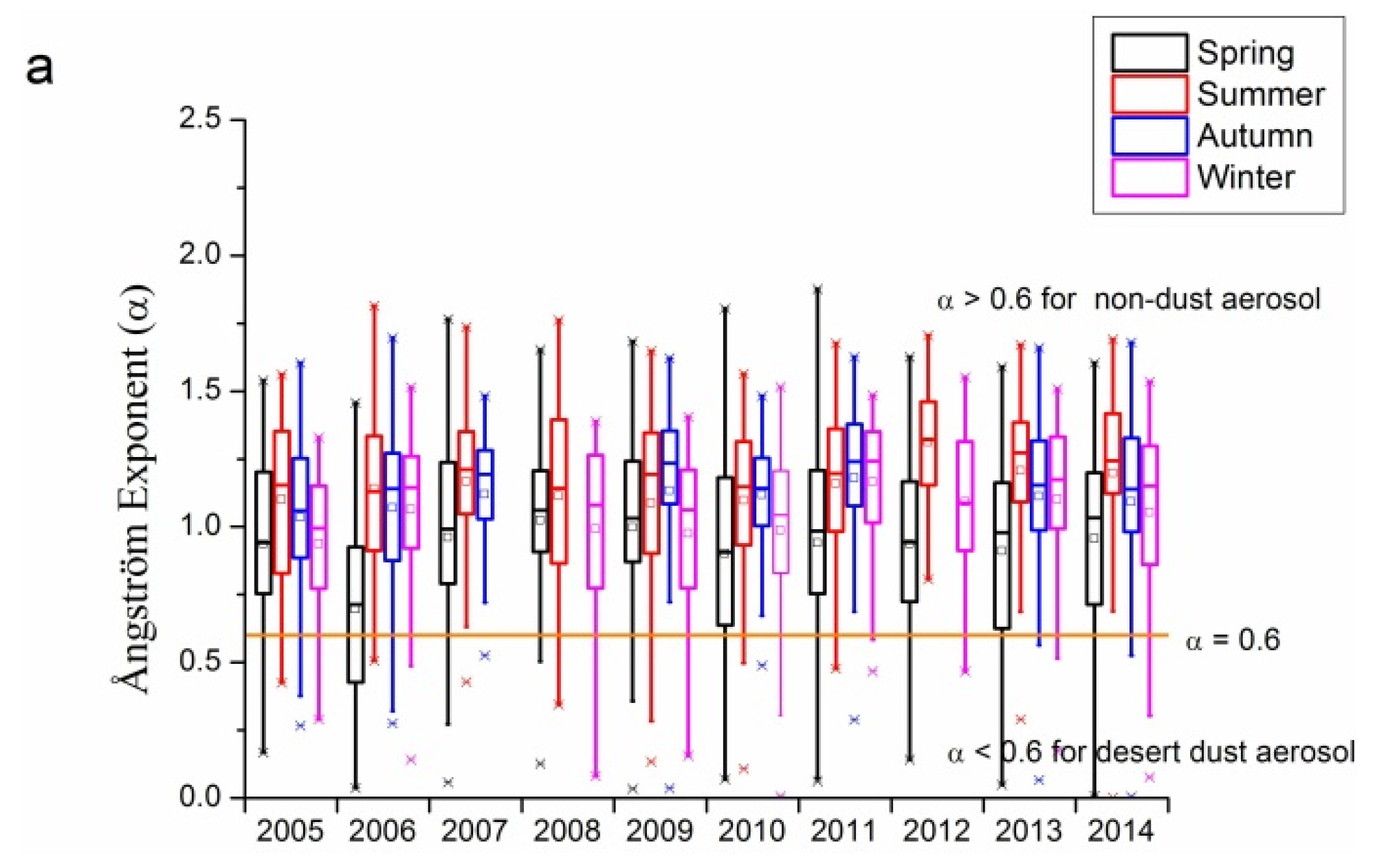
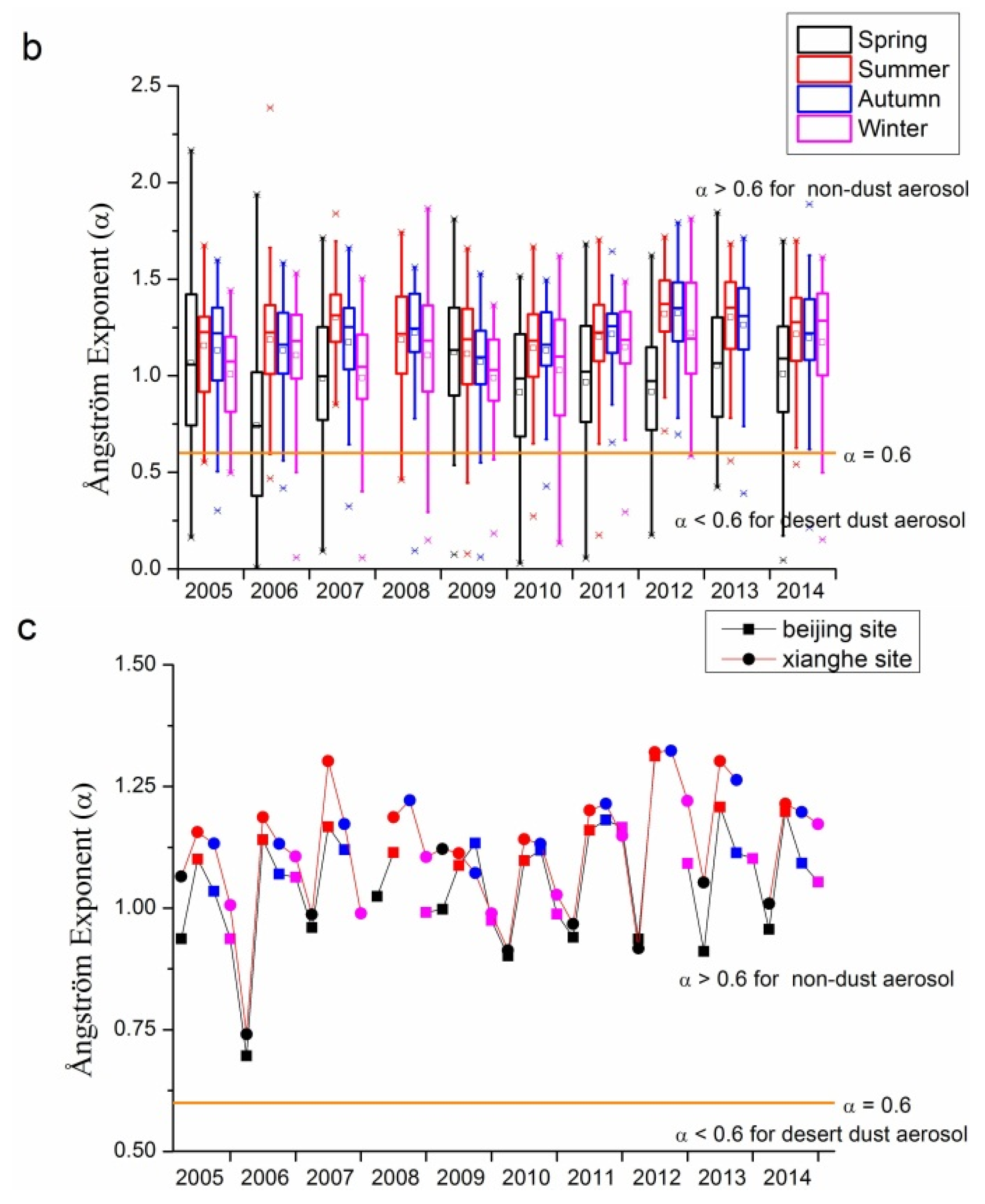
3.3. Volume Size Distribution

3.4. Single Scattering Albedo
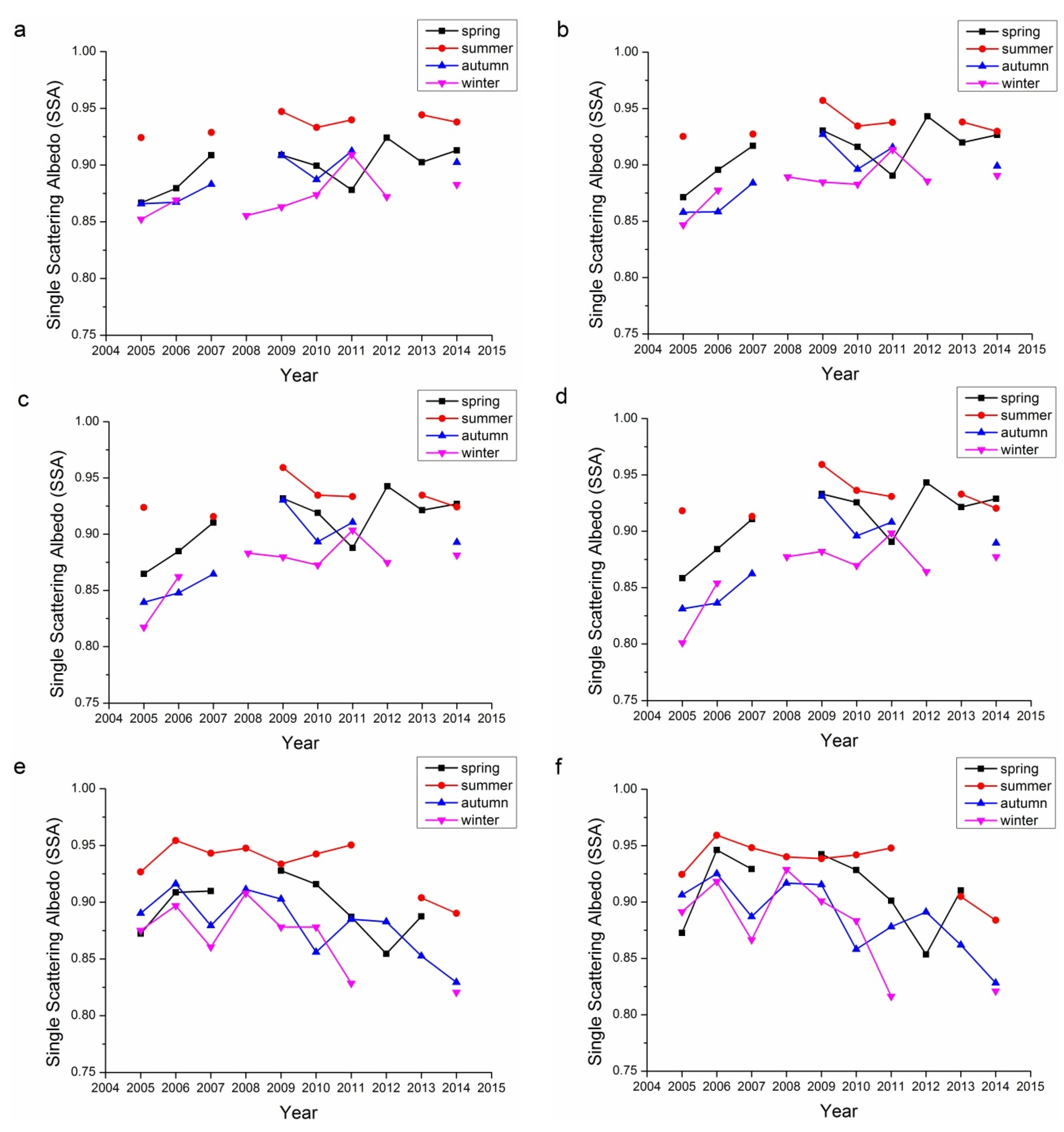
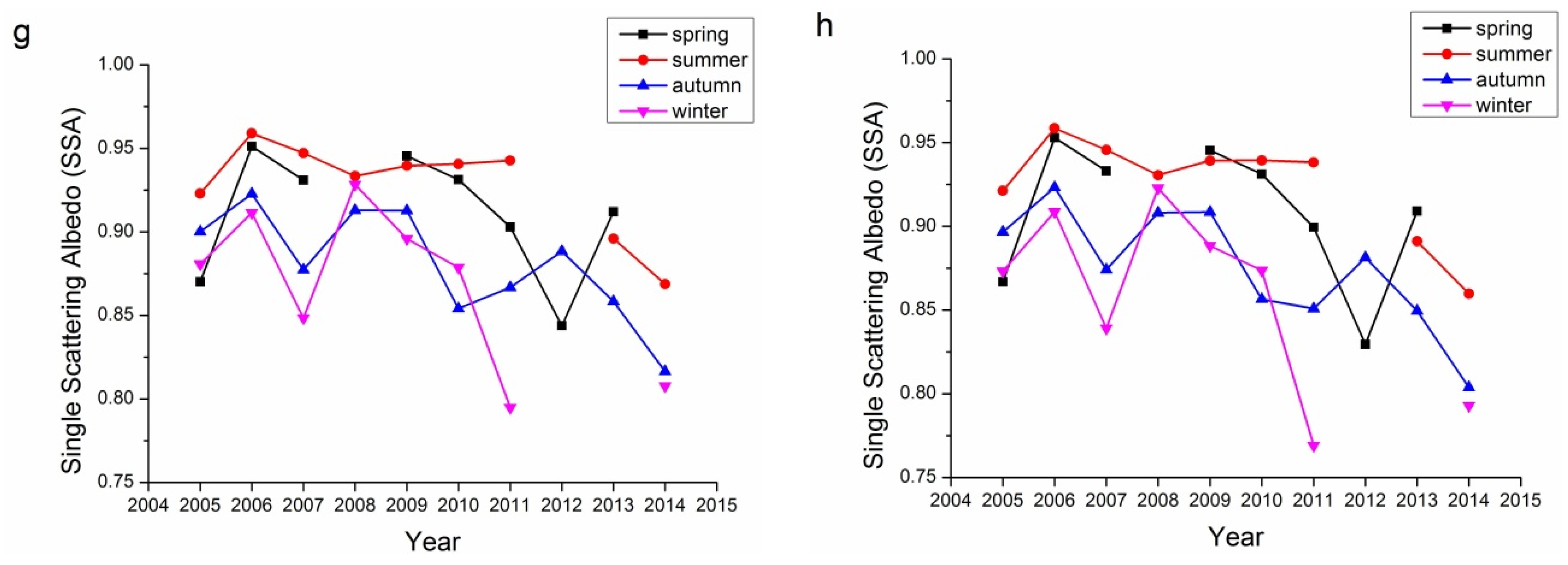
3.5. Refractive Index
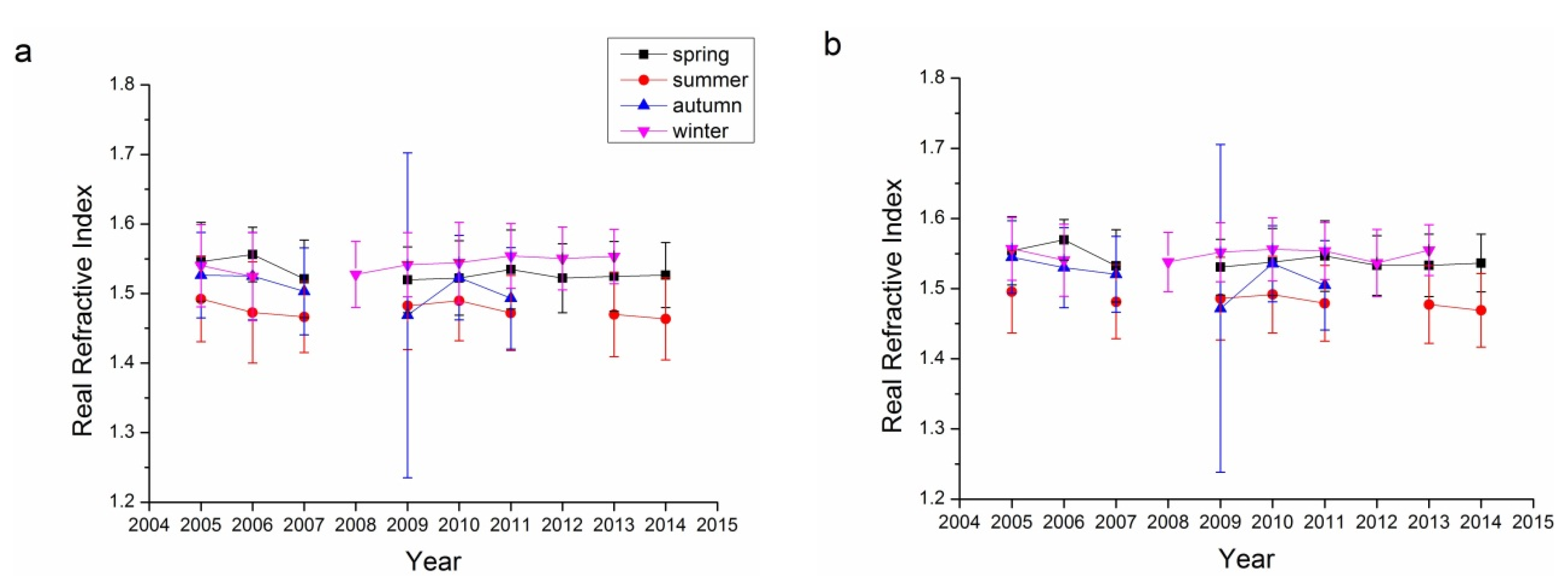
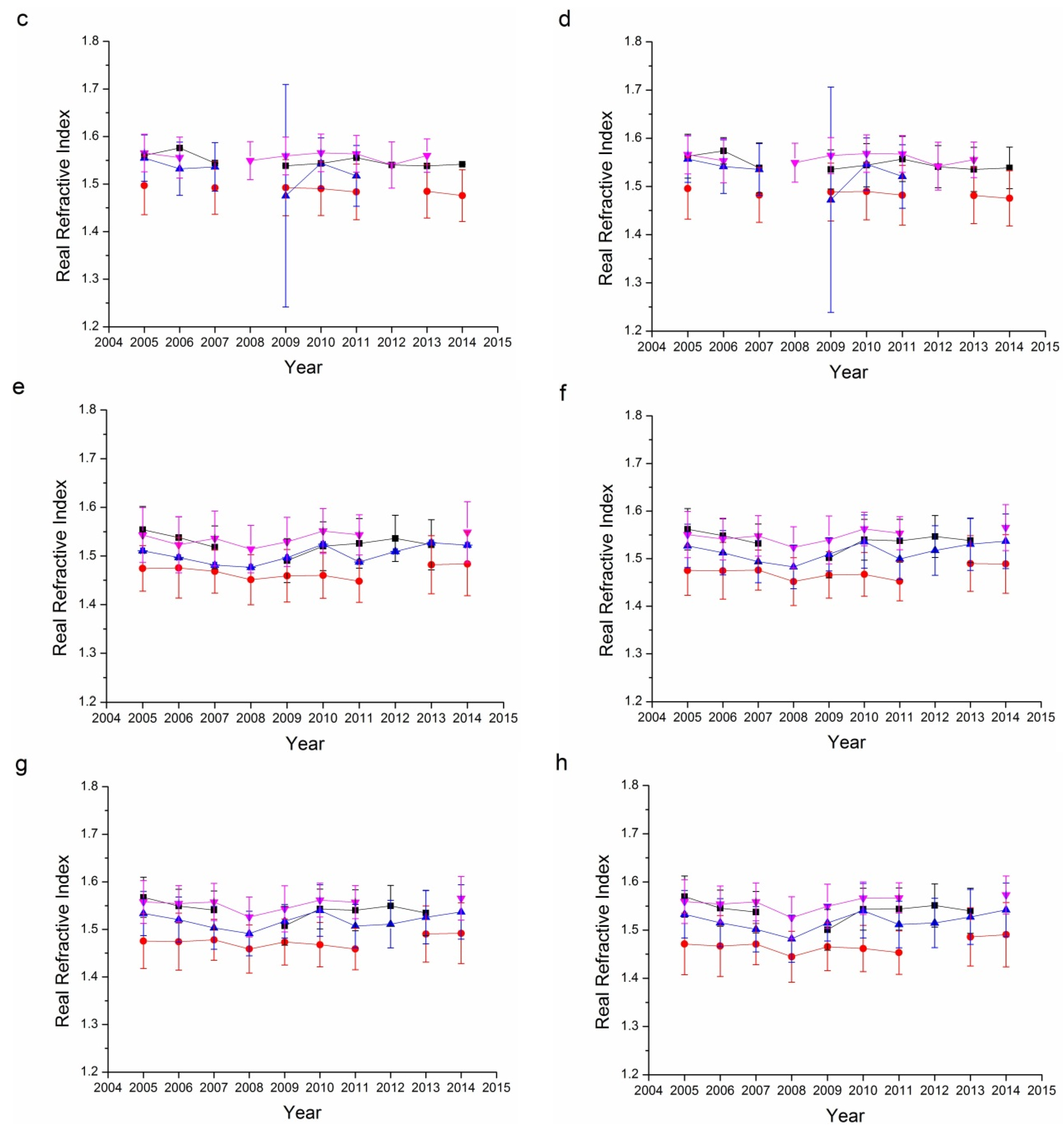
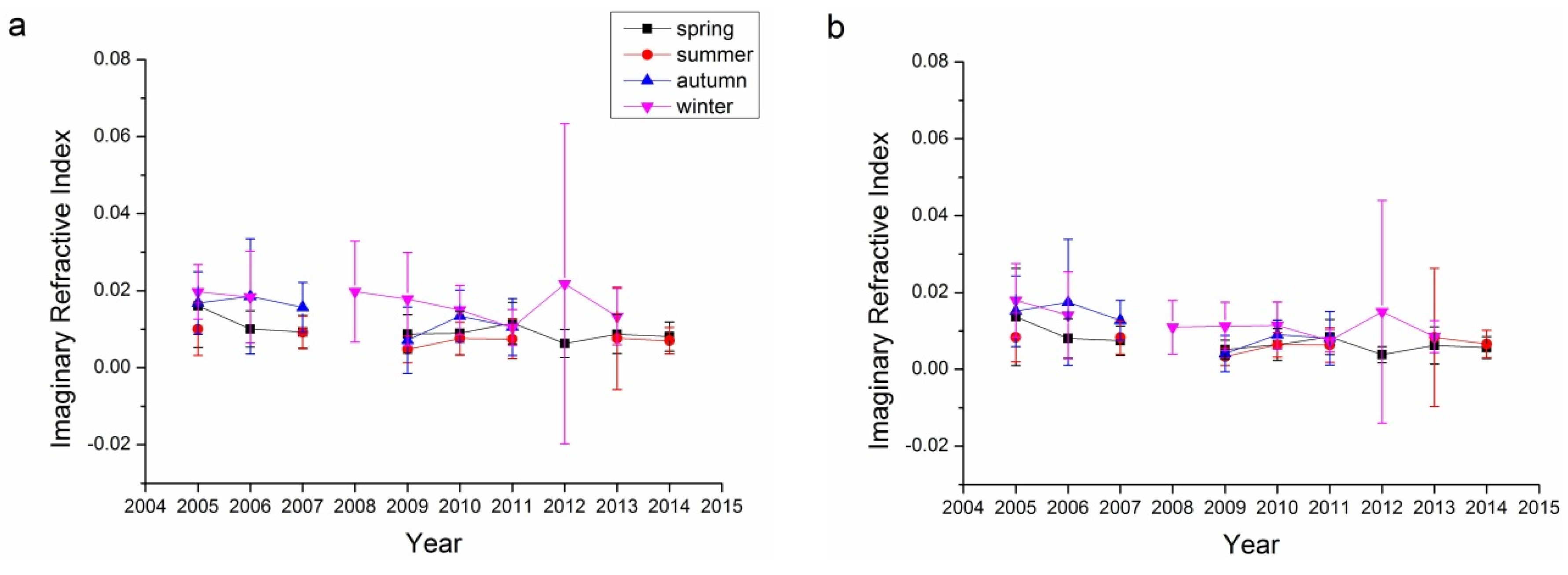
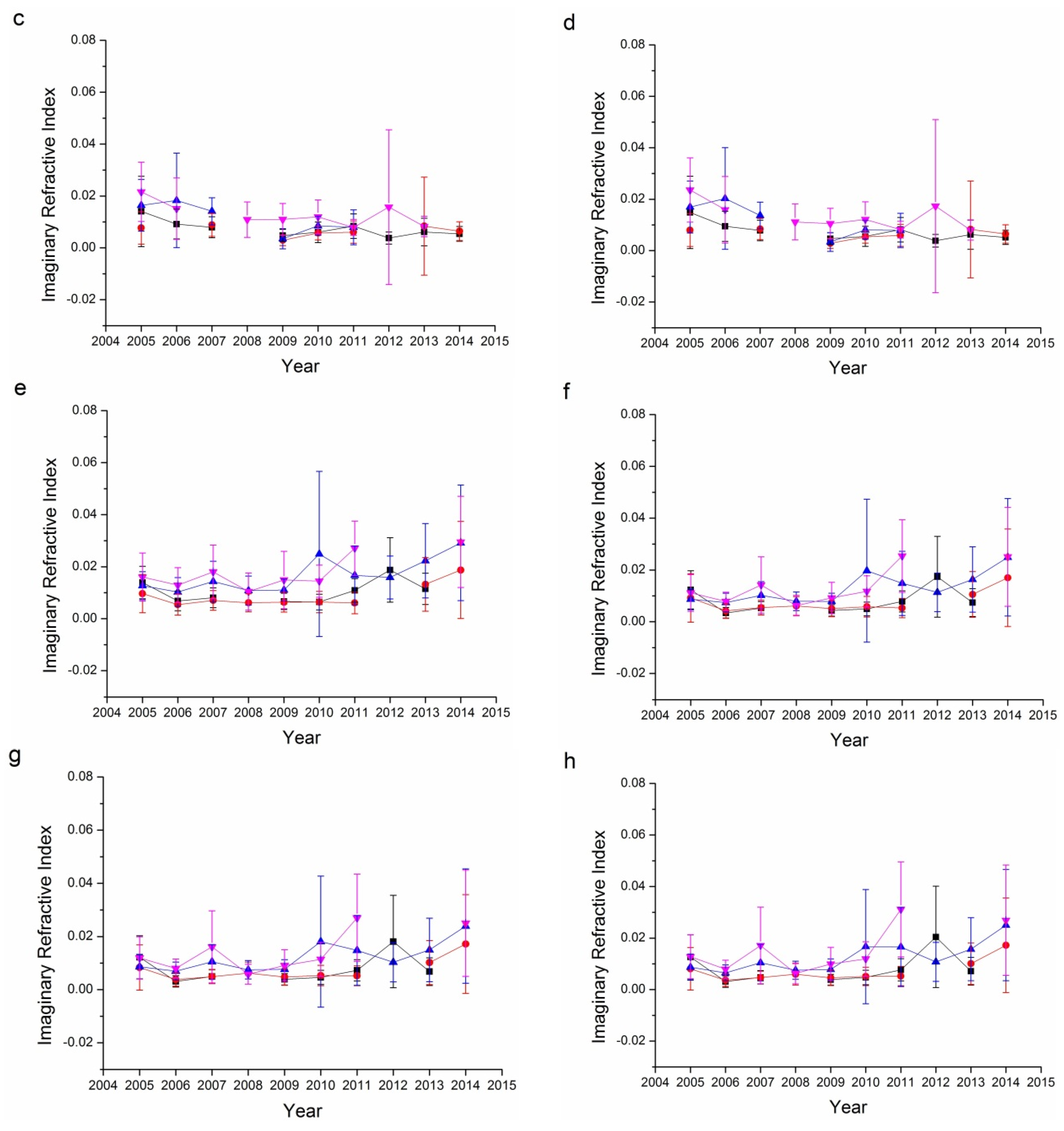
4. Discussion
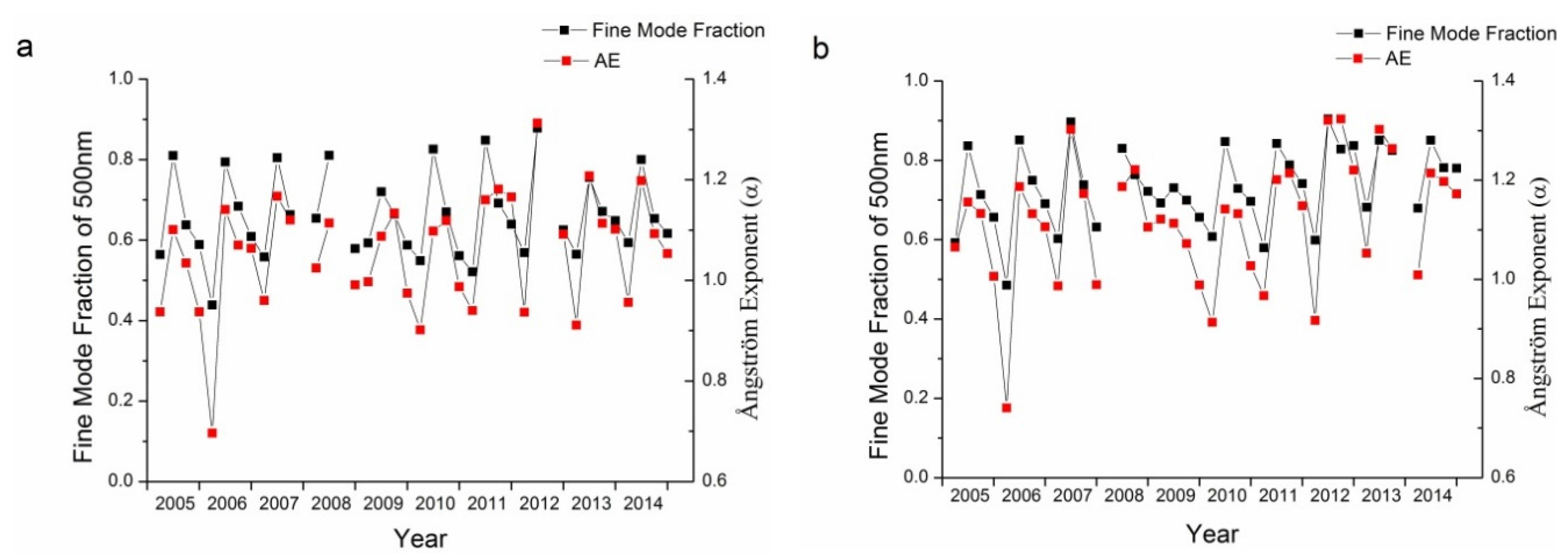
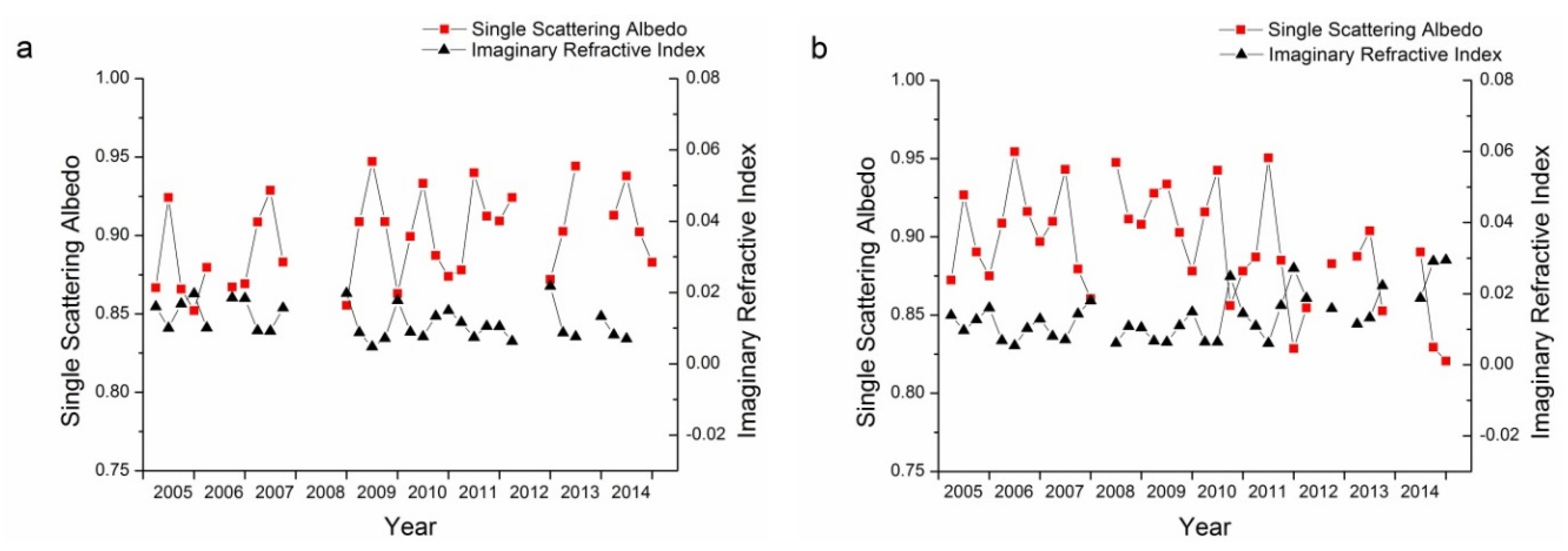
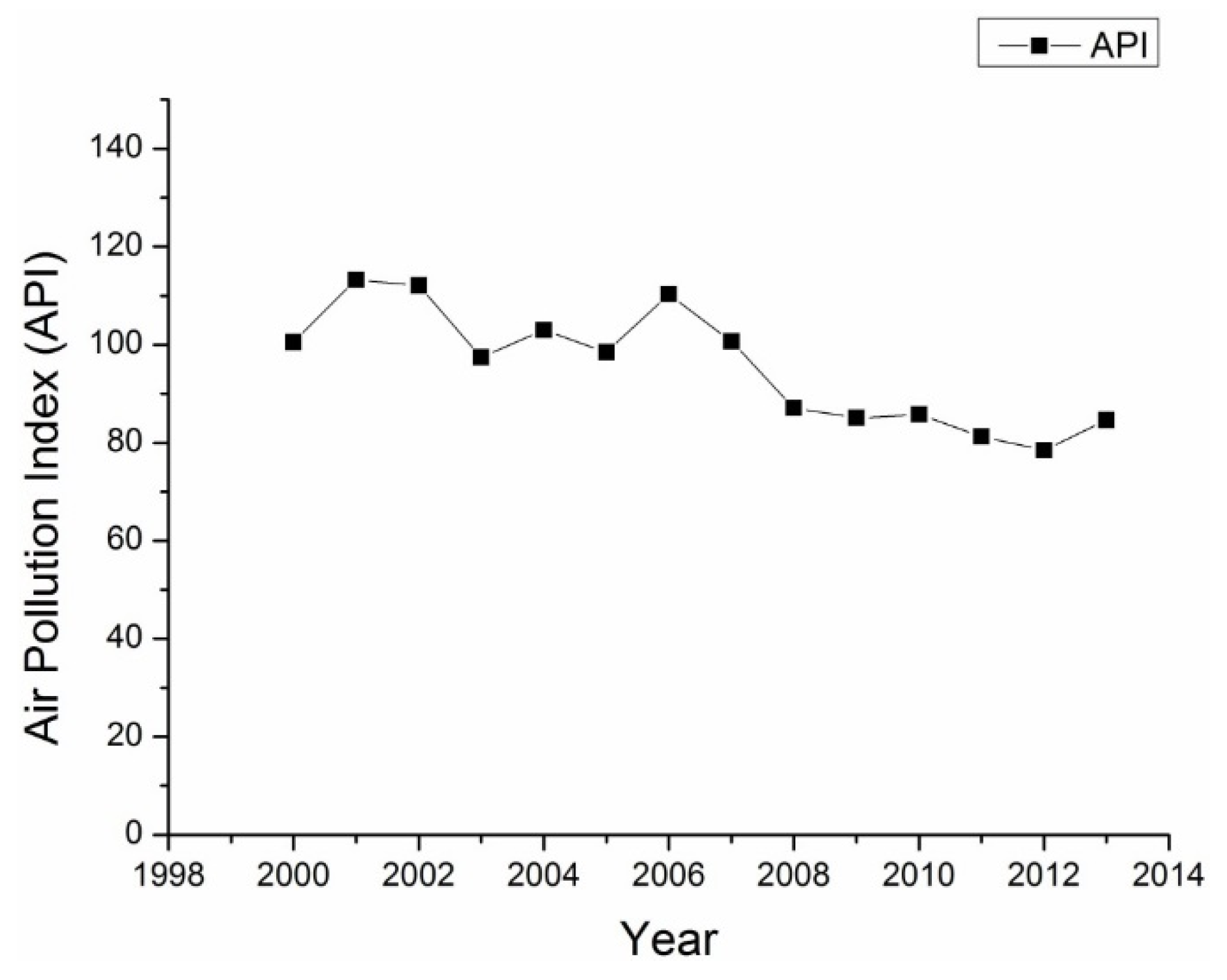
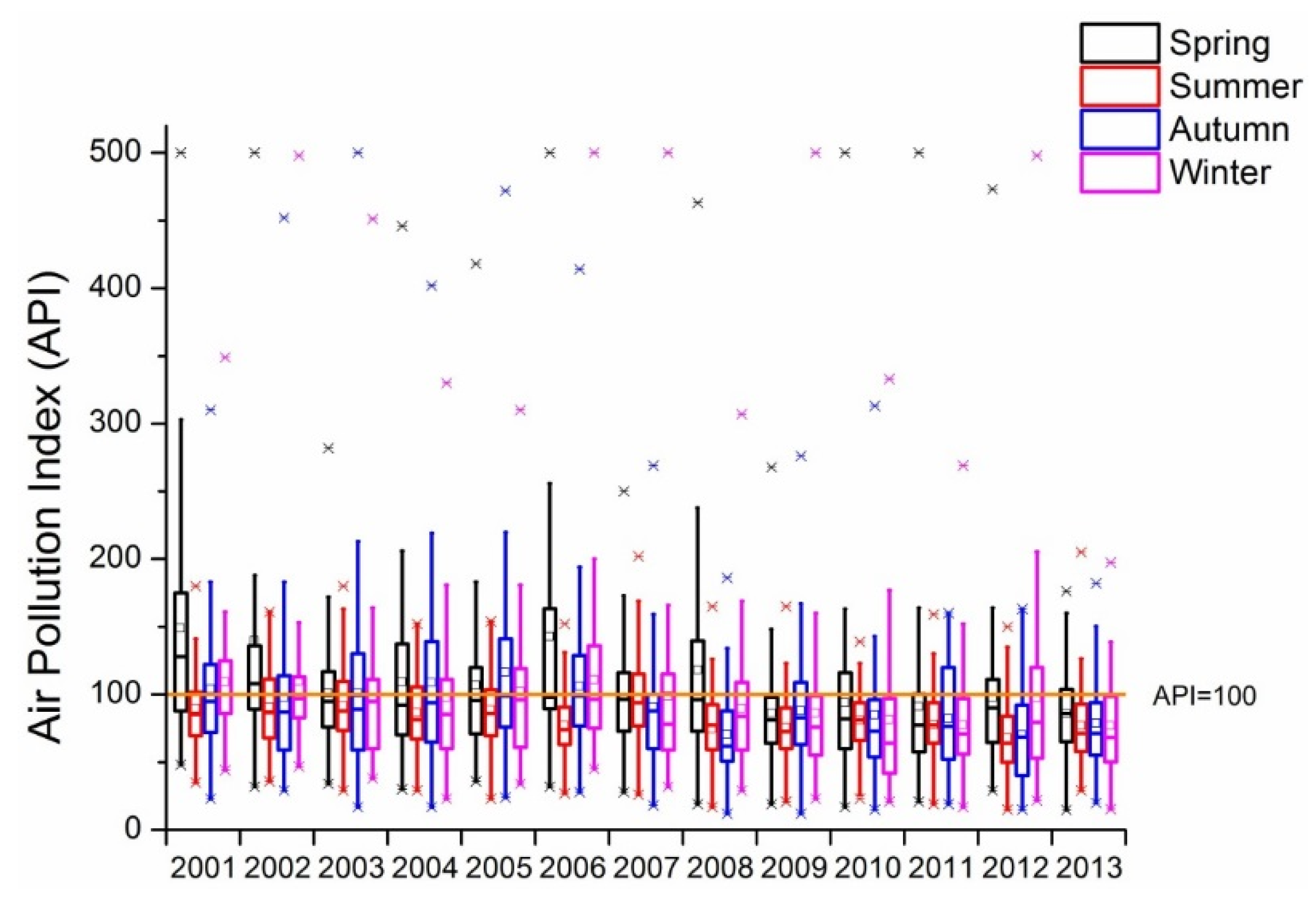
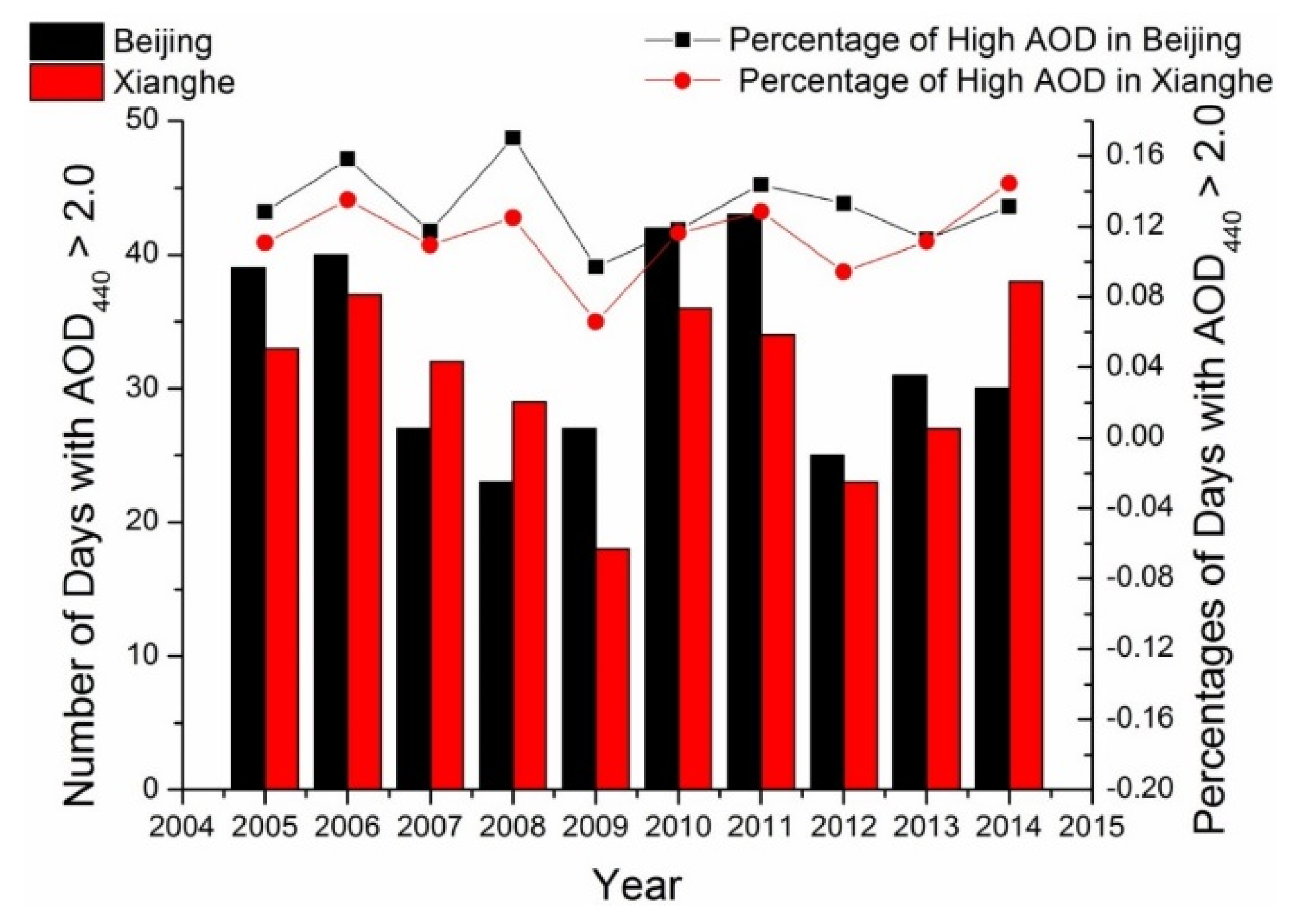
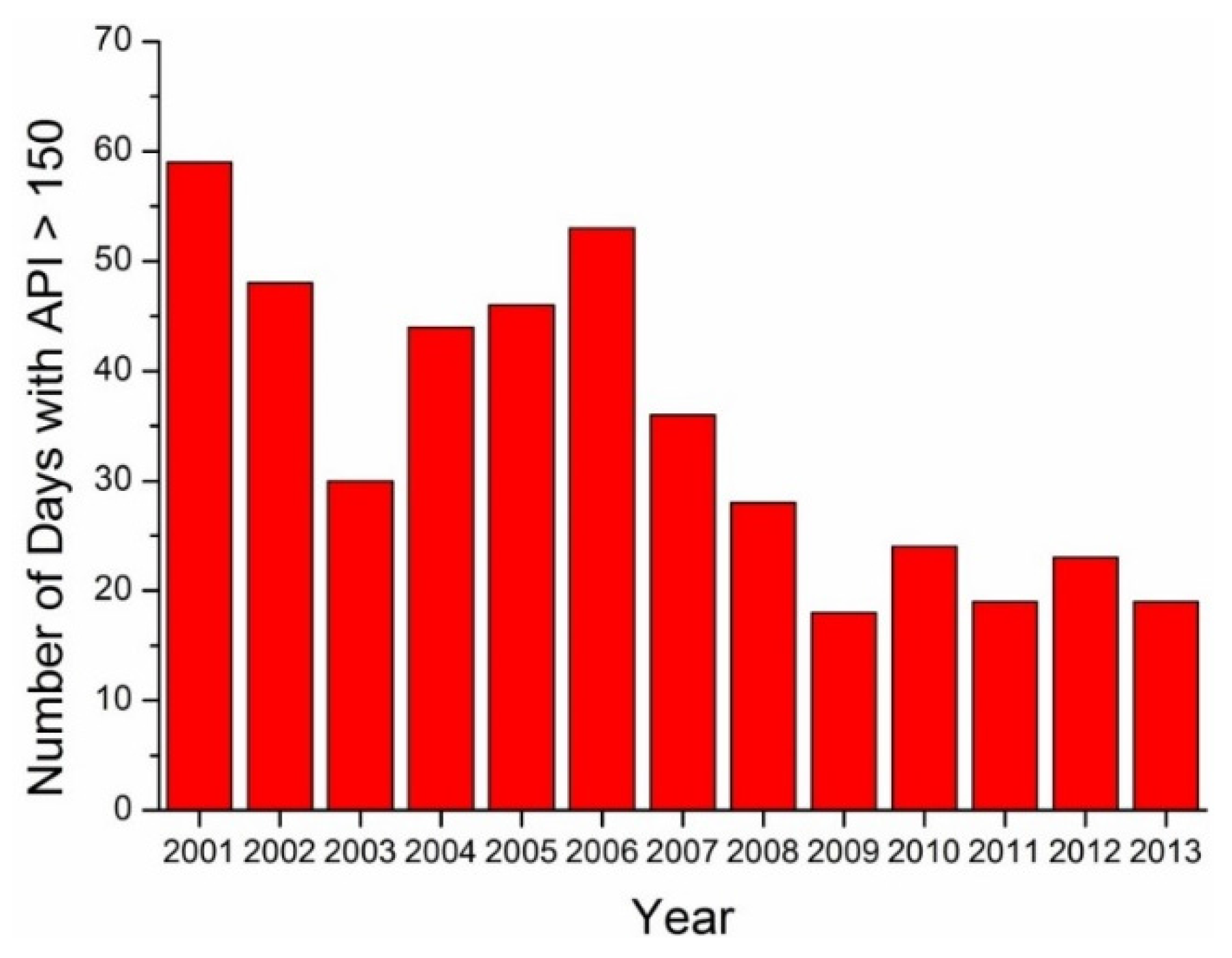
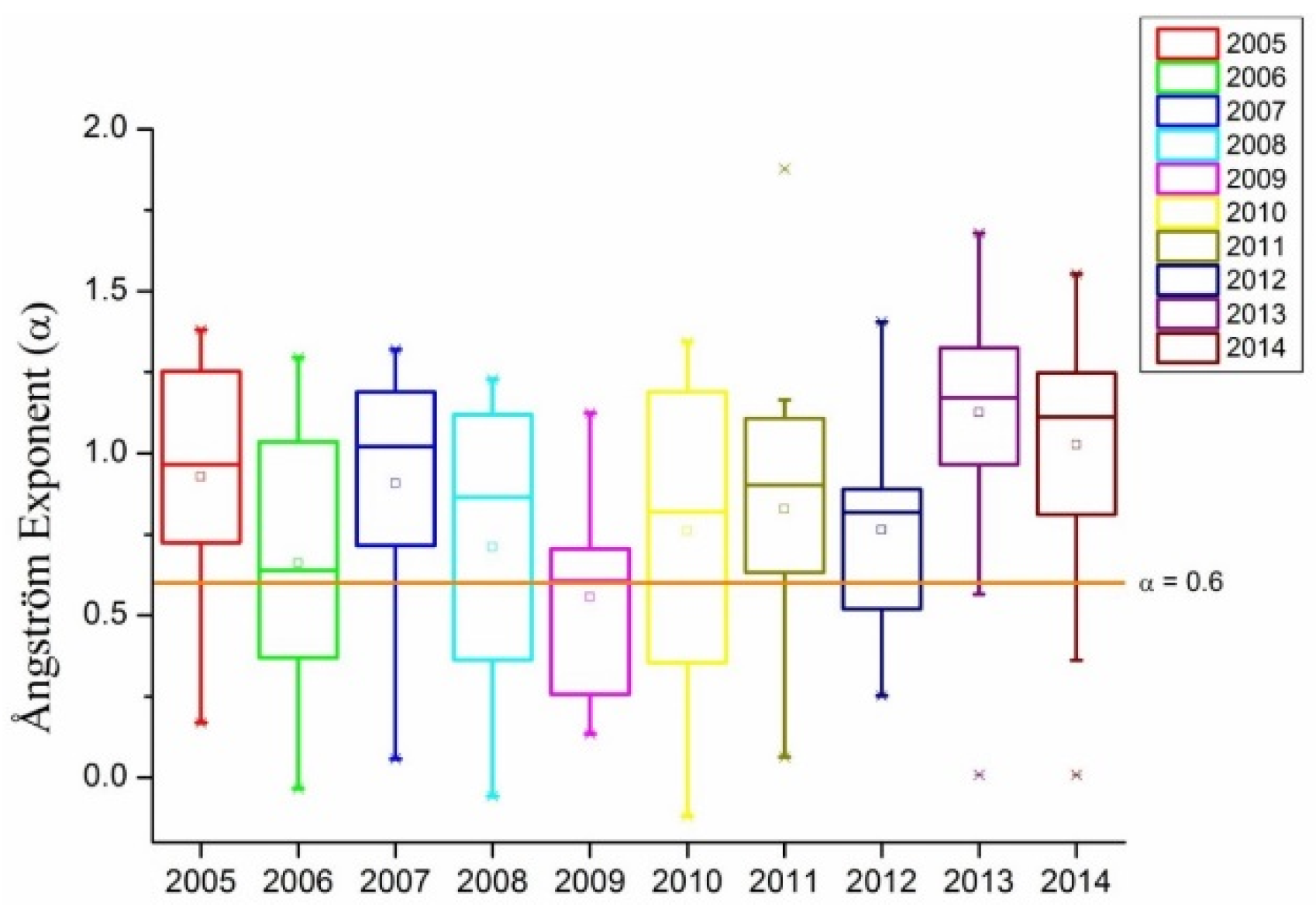

5. Summary and Conclusions
Acknowledgments
Author Contributions
Conflicts of Interest
References
- Zhou, M.G.; Liu, Y.N.; Wang, L.J.; Kuang, X.Y.; Xu, X.H.; Kan, H.D. Particulate air pollution and mortality in a cohort of chinese men. Environ. Pollut. 2014, 186, 1–6. [Google Scholar] [CrossRef] [PubMed]
- Langrish, J.P.; Mills, N.L. Air pollution and mortality in europe. Lancet 2014, 383, 758–760. [Google Scholar] [CrossRef]
- Schwartz, J.; Neas, L.M. Fine particles are more strongly associated than coarse particles with acute respiratory health effects in schoolchildren. Epidemiology 2000, 11, 6–10. [Google Scholar] [CrossRef] [PubMed]
- Sayer, A.M.; Munchak, L.A.; Hsu, N.C.; Levy, R.C.; Bettenhausen, C.; Jeong, M.J. MODIS collection 6 aerosol products: Comparison between aqua’s e-deep blue, dark target, and “merged” data sets, and usage recommendations. J. Geophys. Res. Atmos. 2014, 119, 13965–13989. [Google Scholar] [CrossRef]
- Li, Z.Q.; Niu, F.; Fan, J.W.; Liu, Y.G.; Rosenfeld, D.; Ding, Y.N. Long-term impacts of aerosols on the vertical development of clouds and precipitation. Nat. Geosci. 2011, 4, 888–894. [Google Scholar] [CrossRef]
- Janssen, N.A.H.; Fischer, P.; Marra, M.; Ameling, C.; Cassee, F.R. Short-term effects of PM2.5, PM10 and PM2.5–10 on daily mortality in the Netherlands. Sci. Total Environ. 2013, 463, 20–26. [Google Scholar] [CrossRef] [PubMed]
- Chen, R.; Peng, R.D.; Meng, X.; Zhou, Z.; Chen, B.; Kan, H. Seasonal variation in the acute effect of particulate air pollution on mortality in the China air pollution and health effects study (Capes). Sci. Total Environ. 2013, 450, 259–265. [Google Scholar] [CrossRef] [PubMed]
- Bergen, S.; Sheppard, L.; Sampson, P.D.; Kim, S.Y.; Richards, M.; Vedal, S.; Kaufman, J.D.; Szpiro, A.A. A national prediction model for PM2.5 component exposures and measurement error-corrected health effect inference. Environ. Health Perspect. 2013, 121, 1017–1025. [Google Scholar] [CrossRef] [PubMed]
- Levy, R.C.; Mattoo, S.; Munchak, L.A.; Remer, L.A.; Sayer, A.M.; Patadia, F.; Hsu, N.C. The collection 6 MODIS aerosol products over land and ocean. Atmos. Meas. Tech. 2013, 6, 2989–3034. [Google Scholar] [CrossRef]
- Remer, L.A.; Kaufman, Y.J.; Tanre, D.; Mattoo, S.; Chu, D.A.; Martins, J.V.; Li, R.R.; Ichoku, C.; Levy, R.C.; Kleidman, R.G.; et al. The MODIS aerosol algorithm, products, and validation. J. Atmos. Sci. 2005, 62, 947–973. [Google Scholar] [CrossRef]
- Li, Z.Q.; Niu, F.; Lee, K.H.; Xin, J.Y.; Hao, W.M.; Nordgren, B.; Wang, Y.S.; Wang, P.C. Validation and understanding of moderate resolution imaging spectroradiometer aerosol products (C5) using ground-based measurements from the handheld sun photometer network in China. J. Geophys. Res. 2007, 112. [Google Scholar] [CrossRef]
- Levy, R.C.; Remer, L.A.; Kaufman, Y.J. Effects of neglecting polarization on the MODIS aerosol retrieval over land. IEEE Trans. Geosci. Remote Sens. 2004, 42, 2576–2583. [Google Scholar] [CrossRef]
- Hasekamp, O.P.; Litvinov, P.; Butz, A. Aerosol properties over the ocean from parasol multiangle photopolarimetric measurements. J. Geophys. Res. 2011, 116. [Google Scholar] [CrossRef]
- Diner, D.J.; Martonchik, J.V.; Kahn, R.A.; Pinty, B.; Gobron, N.; Nelson, D.L.; Holben, B.N. Using angular and spectral shape similarity constraints to improve misr aerosol and surface retrievals over land. Remote Sens. Environ. 2005, 94, 155–171. [Google Scholar] [CrossRef]
- Tao, M.H.; Chen, L.F.; Wang, Z.F.; Tao, J.H.; Che, H.Z.; Wang, X.H.; Wang, Y. Comparison and evaluation of the MODIS collection 6 aerosol data in China. J. Geophys. Res. Atmos. 2015, 120, 6992–7005. [Google Scholar] [CrossRef]
- Sayer, A.M.; Hsu, N.C.; Bettenhausen, C.; Jeong, M.J. Validation and uncertainty estimates for MODIS collection 6 “Deep Blue” aerosol data. J. Geophys. Res. Atmos. 2013, 118, 7864–7872. [Google Scholar] [CrossRef]
- Dubovik, O.; Smirnov, A.; Holben, B.N.; King, M.D.; Kaufman, Y.J.; Eck, T.F.; Slutsker, I. Accuracy assessments of aerosol optical properties retrieved from aerosol robotic network (AERONET) sun and sky radiance measurements. J. Geophys. Res. Atmos. 2000, 105, 9791–9806. [Google Scholar] [CrossRef]
- Che, H.; Shi, G.; Uchiyama, A.; Yamazaki, A.; Chen, H.; Goloub, P.; Zhang, X. Intercomparison between aerosol optical properties by a prede skyradiometer and cimel sunphotometer over Beijing, China. Atmos. Chem. Phys. 2008, 8, 3199–3214. [Google Scholar] [CrossRef]
- Eck, T.F.; Holben, B.N.; Dubovik, O.; Smirnov, A.; Goloub, P.; Chen, H.B.; Chatenet, B.; Gomes, L.; Zhang, X.Y.; Tsay, S.C.; et al. Columnar aerosol optical properties at aeronet sites in central Eastern Asia and aerosol transport to the tropical Mid-Pacific. J. Geophys. Res. Atmos. 2005, 110. [Google Scholar] [CrossRef]
- Zhu, J.; Xia, X.; Che, H.; Wang, J.; Zhang, J.; Duan, Y. Study of aerosol optical properties at Kunming in southwest China and long-range transport of biomass burning aerosols from North Burma. Atmos. Res. A 2016, 169, 237–247. [Google Scholar] [CrossRef]
- Zhang, J.; Chen, J.; Xia, X.; Che, H.; Fan, X.; Xie, Y.; Han, Z.; Chen, H.; Lu, D. Heavy aerosol loading over the Bohai bay as revealed by ground and satellite remote sensing. Atmos. Environ. B 2016, 124, 252–261. [Google Scholar] [CrossRef]
- Xin, J.Y.; Wang, Y.S.; Li, Z.Q.; Wang, P.C.; Hao, W.M.; Nordgren, B.L.; Wang, S.G.; Liu, G.R.; Wang, L.L.; Wen, T.X.; et al. Aerosol optical depth (AOD) and angstrom exponent of aerosols observed by the Chinese sun hazemeter network from August 2004 to September 2005. J. Geophys. Res. Atmos. 2007, 112. [Google Scholar] [CrossRef]
- O’Neill, N.T.; Ignatov, A.; Holben, B.N.; Eck, T.F. The lognormal distribution as a reference for reporting aerosol optical depth statistics; empirical tests using multi-year, multi-site aeronet sunphotometer data. Geophys. Res. Lett. 2000, 27, 3333–3336. [Google Scholar]
- Behnert, I.; Matthias, V.; Doerffer, R. Aerosol climatology from ground-based measurements for the Southern North Sea. Atmos. Res. 2007, 84, 201–220. [Google Scholar] [CrossRef]
- Yoon, J.; Pozzer, A.; Chang, D.Y.; Lelieveld, J.; Kim, J.; Kim, M.; Lee, Y.G.; Koo, J.H.; Lee, J.; Moon, K.J. Trend estimates of aeronet-observed and model-simulated AOTS between 1993 and 2013. Atmos. Environ. A 2016, 125, 33–47. [Google Scholar] [CrossRef]
- Schuster, G.L.; Vaughan, M.; MacDonnell, D.; Su, W.; Winker, D.; Dubovik, O.; Lapyonok, T.; Trepte, C. Comparison of calipso aerosol optical depth retrievals to aeronet measurements, and a climatology for the lidar ratio of dust. Atmos. Chem. Phys. 2012, 12, 7431–7452. [Google Scholar] [CrossRef]
- Garcia, O.E.; Diaz, J.P.; Exposito, F.J.; Diaz, A.M.; Dubovik, O.; Derimian, Y.; Dubuisson, P.; Roger, J.C. Shortwave radiative forcing and efficiency of key aerosol types using aeronet data. Atmos. Chem. Phys. 2012, 12, 5129–5145. [Google Scholar] [CrossRef]
- Lee, J.; Kim, J.; Yang, P.; Hsu, N.C. Improvement of aerosol optical depth retrieval from MODIS spectral reflectance over the global ocean using new aerosol models archived from aeronet inversion data and tri-axial ellipsoidal dust database. Atmos. Chem. Phys. 2012, 12, 7087–7102. [Google Scholar] [CrossRef]
- Grosso, N.; Paronis, D. Comparison of contrast reduction based MODIS AOT estimates with AERONET measurements. Atmos. Res. 2012, 116, 33–45. [Google Scholar] [CrossRef]
- Cheng, T.; Chen, H.; Gu, X.; Yu, T.; Guo, J.; Guo, H. The inter-comparison of MODIS, misr and gocart aerosol products against aeronet data over China. J. Quant. Spectrosc. Radiat. Transf. 2012, 113, 2135–2145. [Google Scholar] [CrossRef]
- Mi, W.; Li, Z.; Xia, X.; Holben, B.; Levy, R.; Zhao, F.; Chen, H.; Cribb, M. Evaluation of the moderate resolution imaging spectroradiometer aerosol products at two aerosol robotic network stations in China. J. Geophys. Res. Atmos. 2007, 112. [Google Scholar] [CrossRef]
- Che, H.; Xia, X.; Zhu, J.; Li, Z.; Dubovik, O.; Holben, B.; Goloub, P.; Chen, H.; Estelles, V.; Cuevas-Agullo, E.; et al. Column aerosol optical properties and aerosol radiative forcing during a serious haze-fog month over north China plain in 2013 based on ground-based sunphotometer measurements. Atmos. Chem. Phys. 2014, 14, 2125–2138. [Google Scholar] [CrossRef]
- Li, Z.; Xia, X.; Cribb, M.; Mi, W.; Holben, B.; Wang, P.; Chen, H.; Tsay, S.-C.; Eck, T.F.; Zhao, F.; et al. Aerosol optical properties and their radiative effects in northern China. J. Geophys. Res. Atmos. 2007, 112. [Google Scholar] [CrossRef]
- Xia, X.A.; Chen, H.B.; Wang, P.C.; Zong, X.M.; Qiu, J.H.; Gouloub, P. Aerosol properties and their spatial and temporal variations over north China in Spring 2001. Tellus B Chem. Phys. Meteorol. 2005, 57, 28–39. [Google Scholar]
- Zhang, A.; Qi, Q.; Jiang, L.; Zhou, F.; Wang, J. Population exposure to PM2.5 in the urban area of Beijing. PLoS ONE 2013, 8, e63486. [Google Scholar] [CrossRef] [PubMed]
- Li, R.; Li, Z.; Gao, W.; Ding, W.; Xu, Q.; Song, X. Diurnal, seasonal, and spatial variation of PM2.5 in Beijing. Sci. Bull. 2015, 60, 387–395. [Google Scholar] [CrossRef]
- Guo, Y.; Feng, N.; Christopher, S.A.; Kang, P.; Zhan, F.B.; Hong, S. Satellite remote sensing of fine particulate matter (PM2.5) air quality over Beijing using MODIS. Int. J. Remote Sens. 2014, 35, 6522–6544. [Google Scholar] [CrossRef]
- Zhang, R.; Jing, J.; Tao, J.; Hsu, S.C.; Wang, G.; Cao, J.; Lee, C.S.L.; Zhu, L.; Chen, Z.; Zhao, Y.; et al. Chemical characterization and source apportionment of PM2.5 in Beijing: Seasonal perspective. Atmos. Chem. Phys. 2013, 13, 7053–7074. [Google Scholar] [CrossRef]
- He, X.; Li, C.C.; Lau, A.K.H.; Deng, Z.Z.; Mao, J.T.; Wang, M.H.; Liu, X.Y. An intensive study of aerosol optical properties in Beijing urban area. Atmos. Chem. Phys. 2009, 9, 8903–8915. [Google Scholar] [CrossRef]
- Liu, P.F.; Zhao, C.S.; Zhang, Q.; Deng, Z.Z.; Huang, M.Y.; Ma, X.C.; Tie, X.X. Aircraft study of aerosol vertical distributions over Beijing and their optical properties. Tellus B Chem. Phys. Meteorol. 2009, 61, 756–767. [Google Scholar] [CrossRef]
- Li, Z.; Gu, X.; Wang, L.; Li, D.; Xie, Y.; Li, K.; Dubovik, O.; Schuster, G.; Goloub, P.; Zhang, Y.; et al. Aerosol physical and chemical properties retrieved from ground-based remote sensing measurements during heavy haze days in Beijing winter. Atmos. Chem. Phys. 2013, 13, 10171–10183. [Google Scholar] [CrossRef] [Green Version]
- Dubovik, O.; Sinyuk, A.; Lapyonok, T.; Holben, B.N.; Mishchenko, M.; Yang, P.; Eck, T.F.; Volten, H.; Munoz, O.; Veihelmann, B.; et al. Application of spheroid models to account for aerosol particle nonsphericity in remote sensing of desert dust. J. Geophys. Res. 2006, 111. [Google Scholar] [CrossRef]
- Fan, X.H.; Xia, X.A.; Chen, H.B. Comparison of column-integrated aerosol optical and physical properties in an urban and suburban site on the north China plain. Adv. Atmos. Sci. 2015, 32, 477–486. [Google Scholar] [CrossRef]
- Dubovik, O.; King, M.D. A flexible inversion algorithm for retrieval of aerosol optical properties from sun and sky radiance measurements. J. Geophys. Res. 2000, 105, 20673–20696. [Google Scholar] [CrossRef]
- Dubovik, O.; Herman, M.; Holdak1, A.; Lapyonok, T.; Tanre, D.; Deuze, J.L.; Ducos, F.; Sinyuk, A.; Lopatin, A. Statistically optimized inversion algorithm for enhanced retrieval of aerosol properties from spectral multi-angle polarimetric satellite observations. Atmos. Meas. Tech. 2011, 4, 975–1018. [Google Scholar] [CrossRef] [Green Version]
- Smirnov, A.; Holben, B.N.; Eck, T.F.; Dubovik, O.; Slutsker, I. Cloud-screening and quality control algorithms for the aeronet database. Remote Sens. Environ. 2000, 73, 337–349. [Google Scholar] [CrossRef]
- Distribution of Real Time Air Quality of Beijing. Available online: http://www.bjmemc.com.cn/ (accessed on 29 January 2016).
- Chen, W.; Wang, F.; Xiao, G.; Wu, K.; Zhang, S. Air quality of Beijing and impacts of the new ambient air quality standard. Atmosphere 2015, 6, 1243–1258. [Google Scholar] [CrossRef]
- Distribution of Real Time Air Qulaity of China. Available online: http://113.108.142.147:20035/emcpublish/ (accessed on 29 January 2016).
- Xie, Y.; Li, Z.; Li, D.; Xu, H.; Li, K. Aerosol optical and microphysical properties of four typical sites of sonet in China based on remote sensing measurements. Remote Sens. 2015, 7, 9928–9953. [Google Scholar] [CrossRef]
- Eck, T.F.; Holben, B.N.; Sinyuk, A.; Pinker, R.T.; Goloub, P.; Chen, H.; Chatenet, B.; Li, Z.; Singh, R.P.; Tripathi, S.N.; et al. Climatological aspects of the optical properties of fine/coarse mode aerosol mixtures. J. Geophys. Res. Atmos. 2010, 115. [Google Scholar] [CrossRef]
- He, Q.S.; Li, C.C.; Geng, F.H.; Yang, H.Q.; Li, P.R.; Li, T.T.; Liu, D.W.; Pei, Z. Aerosol optical properties retrieved from sun photometer measurements over Shanghai, China. J. Geophys. Res. Atmos. 2012, 117. [Google Scholar] [CrossRef]
- Fan, X.; Chen, H.; Goloub, P.; Xia, X.A.; Zhang, W.; Chatenet, B. Analysis of column-integrated aerosol optical thickness in Beijing from aeronet observations. China Particuol. 2006, 4, 330–335. [Google Scholar] [CrossRef]
- Lyapustin, A.; Smirnov, A.; Holben, B.; Chin, M.; Streets, D.G.; Lu, Z.; Kahn, R.; Slutsker, I.; Laszlo, I.; Kondragunta, S.; et al. Reduction of aerosol absorption in Beijing since 2007 from MODIS and aeronet. Geophys. Res. Lett. 2011, 38, 415–421. [Google Scholar] [CrossRef]
- Li, J.; Carlson, B.E.; Dubovik, O.; Lacis, A.A. Recent trends in aerosol optical properties derived from aeronet measurements. Atmos. Chem. Phys. 2014, 14, 12271–12289. [Google Scholar] [CrossRef]
- Dubovik, O.; Holben, B.; Eck, T.F.; Smirnov, A.; Kaufman, Y.J.; King, M.D.; Tanre, D.; Slutsker, I. Variability of absorption and optical properties of key aerosol types observed in worldwide locations. J. Atmos. Sci. 2002, 59, 590–608. [Google Scholar] [CrossRef]
- Xia, X.; Che, H.; Zhu, J.; Chen, H.; Cong, Z.; Deng, X.; Fan, X.; Fu, Y.; Goloub, P.; Jiang, H.; et al. Ground-based remote sensing of aerosol climatology in China: Aerosol optical properties, direct radiative effect and its parameterization. Atmos. Environ. B 2016, 124, 243–251. [Google Scholar] [CrossRef]
- Yoon, J.; von Hoyningen-Huene, W.; Kokhanovsky, A.A.; Vountas, M.; Burrows, J.P. Trend analysis of aerosol optical thickness and angstrom exponent derived from the global aeronet spectral observations. Atmos. Meas. Tech. 2012, 5, 1271–1299. [Google Scholar] [CrossRef]
- Jiang, X.; Liu, Y.; Yu, B.; Jiang, M. Comparison of misr aerosol optical thickness with aeronet measurements in Beijing metropolitan area. Remote Sens. Environ. 2007, 107, 45–53. [Google Scholar] [CrossRef]
- Wang, J.; Zhu, C.; Zhu, Y.; Chen, S. Characterization of aerosol properties in Beijing from long-term aeronet monitoring (2003–2012). J. Indian Soc. Remote Sens. 2015, 43, 825–839. [Google Scholar] [CrossRef]
- Chen, W.; Tang, H.; Zhao, H. Diurnal, weekly and monthly spatial variations of air pollutants and air quality of Beijing. Atmos. Environ. 2015, 119, 21–34. [Google Scholar] [CrossRef]
- Zhang, H.; Wang, Y.; Hu, J.; Ying, Q.; Hu, X.-M. Relationships between meteorological parameters and criteria air pollutants in three megacities in China. Environ. Res. 2015, 140, 242–254. [Google Scholar] [CrossRef] [PubMed]
- San Martini, F.M.; Hasenkopf, C.A.; Roberts, D.C. Statistical analysis of PM2.5 observations from diplomatic facilities in China. Atmos. Environ. 2015, 110, 174–185. [Google Scholar] [CrossRef]
- Che, H.Z.; Xia, X.G.; Zhu, J.; Wang, H.; Wang, Y.Q.; Sun, J.Y.; Zhang, X.Y.; Shi, G.Y. Aerosol optical properties under the condition of heavy haze over an urban site of Beijing, China. Environ. Sci. Pollut. Res. 2015, 22, 1043–1053. [Google Scholar] [CrossRef] [PubMed]
- Che, H.; Zhang, X.Y.; Xia, X.; Goloub, P.; Holben, B.; Zhao, H.; Wang, Y.; Zhang, X.C.; Wang, H.; Blarel, L.; et al. Ground-based aerosol climatology of China: Aerosol optical depths from the China aerosol remote sensing network (CARSNET) 2002–2013. Atmos. Chem. Phys. 2015, 15, 7619–7652. [Google Scholar] [CrossRef]
- Li, L.J.; Wang, Y.; Zhang, Q.; Li, J.X.; Yang, X.G.; Jin, J. Wheat straw burning and its associated impacts on Beijing air quality. Sci. China Ser. D 2008, 51, 403–414. [Google Scholar] [CrossRef]
© 2016 by the authors; licensee MDPI, Basel, Switzerland. This article is an open access article distributed under the terms and conditions of the Creative Commons by Attribution (CC-BY) license (http://creativecommons.org/licenses/by/4.0/).
Share and Cite
Chen, W.; Tang, H.; Zhao, H.; Yan, L. Analysis of Aerosol Properties in Beijing Based on Ground-Based Sun Photometer and Air Quality Monitoring Observations from 2005 to 2014. Remote Sens. 2016, 8, 110. https://doi.org/10.3390/rs8020110
Chen W, Tang H, Zhao H, Yan L. Analysis of Aerosol Properties in Beijing Based on Ground-Based Sun Photometer and Air Quality Monitoring Observations from 2005 to 2014. Remote Sensing. 2016; 8(2):110. https://doi.org/10.3390/rs8020110
Chicago/Turabian StyleChen, Wei, Hongzhao Tang, Haimeng Zhao, and Lei Yan. 2016. "Analysis of Aerosol Properties in Beijing Based on Ground-Based Sun Photometer and Air Quality Monitoring Observations from 2005 to 2014" Remote Sensing 8, no. 2: 110. https://doi.org/10.3390/rs8020110





